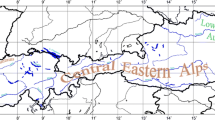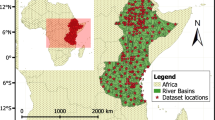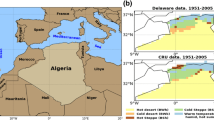Abstract
Climate change in Hungary during the twentieth century is analyzed using Feddema’s original scheme suitable for global scale applications (F-GS) and Feddema’s fine-tuned scheme designed for Hungarian applications (F-HU). Input data of precipitation (P) and air temperature (T) are taken from the Climatic Research Unit (CRU) TS 1.2 database constructing P-T data referring to three 30-year periods (1901–1930, 1941–1970, 1971–2000) and two 50-year periods (1901–1950, 1951–2000). The method and data organizational effects are compared using these schemes and data sets. The results show that the evaluation of the climate change process depends much more on the methodological rather than on data organizational effects. Methodical fine-tuning effects considerably improved the spatial distribution, while the organization of data improved the insight into the dynamic of the processes. According to F-GS, there is no climate change on 76.7 % of Hungarian territory. According to F-HU, such areas amount to only 38.5 %. The main climate change process for F-GS is drying, while for F-HU drying and warming beside either drying or warming. For both models, the most climate change affected areas are characterized by higher altitudes, such as in the Mecsek and Villány Mountains (geographical region Transdanubia), in the Bükk Mountains (geographical region North Hungarian Mountains), and in the region of the so-called Danube Bend. The spatially most realistic climate description is obtained by using F-HU and the 30-year data sets. It is to be noted that Köppen’s, Holdridge’s, and Thornthwaite’s methods are less suitable than F-HU for representing the process of climate change in Hungary in the twentieth century.









Similar content being viewed by others
References
Ács F, Breuer H (2013) Biophysical climate classification methods. (In Hungarian), http://elte.prompt.hu/sites/default/files/tananyagok/09_AcsFerenc-Biofiz_eghoszt_modszerek/index.html
Ács F, Breuer H, Skarbit N (2015) Climate of Hungary in the twentieth century according to Feddema. Theor Appl Climatol 119(1):161–169
Bartholy J (2006) The possible climate consequences of the global climate change in Hungary (in Hungarian). “AGRO-21” Füzetek 48:12–18
Belda M, Skalák P, Farda A, Halenka T, Déqué M, Csima G, Bartholy J, Torma Cs, Boroneant C, Caian M, Spiridonov V (2015) CECILIA Regional Climate Simulations for Future Climate: analysis of climate change signal. Adv Meteorol, Article ID 354727, 13. doi:10.1155/2015/354727
Czúcz B, Gálhidy L, Mátyás Cs (2011) Present and forecasted xeric climatic limits of beech and sessile oak distribution at low altitudes in Central Europe. Ann For Sci 68(1):99–108
Domonkos P, Zoboki J (2000) Climate changes during the 20th century in Hungary. Pr Geol 107:199–206
Fábián ÁP, Matyasovszky I (2010) Analysis of climate change in Hungary according to an extended Köppen classification system, 1971–2060. Időjárás 114(4):251–261
Feddema JJ (2005) A revised Thorntwaite-type global climate classification. Phys Geogr 26:442–466
Führer E, Horváth L, Jagodics A, Machon A, Szabados I (2011) Application of a new aridity index in Hungarian forestry practice. Időjárás 115(3):205–216
Führer E, Jagodics A, Juhász I, Marosi Gy, Horváth L (2013) Ecological and economical impacts of climate change on Hungarian forestry practice. Időjárás 117(2):159–174
Gates DM (1993) Climate change and its biological consequences. Sinauer Associates Inc, USA, 280 p
Harkányi K (2010) Water management and climate change. In: Faragó T, Láng I, Csete L (eds) Climate change and Hungary: mitigating the hazard and preparing for the impacts (The “VAHAVA” report). Hungarian Academy of Sciences, pp 32–37
Holdridge LR (1947) Determination of world plant formations from simple climatic data. Science 105:367–368
Jolánkai M (2010) Agriculture, soil management and climate change. In: Faragó T, Láng I, Csete L (eds) Climate change and Hungary: mitigating the hazard and preparing for the impacts (The “VAHAVA” report). Hungarian Academy of Sciences, pp 38–45
Köppen W (1923) Die Klimate der Erde, Grundriss der Klimakunde. Walter de Gruyter, Berlin
Lakatos M, Szentimrey T, Bihari Z, Szalai S (2013) Creation of a homogenized climate database for the Carpathian region by applying the MASH procedure and the preliminary analysis of the data. Időjarás 117 (1):143–158
Mesterházy I, Mészáros R, Pongrácz R (2014) The effects of climate change on grape production in Hungary. Időjárás 118(3):193–206
Mitchell TD, Carter TR, Jones PD, Hulme M, New M (2004) A comprehensive set of high-resolution grids of monthly climate for Europe and the globe: the observed record (1901–2000) and 16 scenarios (2001–2100). Tyndall Centre Work Pap 55:2–7
Páldy A, Bobvos J, Vámos A, Kovats RS, Hajat S, Kirch W, Menne B (2005) The effect of temperature and heat waves on daily mortality in Budapest, Hungary, 1970–2000. In: Extreme weather events and public health responses. Springer, Verlag, pp 99–107
Szelepcsényi Z, Breuer H, Sümegi P (2014) The climate of Carpathian Region in the 20th century based on the original and modified Holdridge life zone system. Cent Eur J Geosci 6(3):293–307
Thornthwaite CW (1948) An approach toward a rational classification of climate. Geogr Rev 38:5–94
van der Linden P, Mitchell JFB (2009) ENSEMBLES: climate change and its impacts: summary of research and results from the ENSEMBLES project. Met Office Hadley Centre, FitzRoy Road, Exeter EX1 3PB, UK, 160 p
Author information
Authors and Affiliations
Corresponding author
Additional information
The study is financially supported by the Hungarian Scientific Research Fund (OTKA K-81432)
Rights and permissions
About this article
Cite this article
Breuer, H., Ács, F. & Skarbit, N. Climate change in Hungary during the twentieth century according to Feddema. Theor Appl Climatol 127, 853–863 (2017). https://doi.org/10.1007/s00704-015-1670-0
Received:
Accepted:
Published:
Issue Date:
DOI: https://doi.org/10.1007/s00704-015-1670-0




